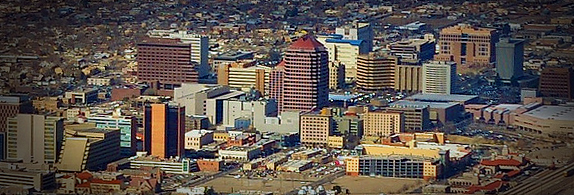
“A cry goes up from the city streets, where wounded men lie groaning.”—The Book of Job.
“Cities are an immense laboratory of trial and error, failure and success.”—Jane Jacobs, “The Death and Life of Great American Cities.”
“Let us pray over the City of Albuquerque.”—Albuquerque-based religious website FGGAM.
Cities, like people, are works in progress. They have life cycles. As Jane Jacobs elucidated in her path-breaking book, The Death and Life of Great American Cities, they may fail or succeed. They are born and grow and thrive. And they shrink and wither and die. Once the process of disintegration gains momentum, a city may reach a turning point and its fate may become irreversible.
Has Albuquerque reached that turning point? Has it arrived at an irreversible point of disintegration? Is it dying? It is almost impossible to be certain of a turning point until it is in the rearview mirror. There are ample signs, however, that Albuquerque may be there.
In major respects it is one of the nation’s failed metropolitan areas, among those with the worst economy, the least effective political leadership, the most unimaginative business community, the most violent police force, the worst child protective services, the highest poverty rate, the worst high school and college dropout rates, the least educated workforce, the greatest government dependence and the worst media news.
Not only is its workforce not growing, it shed 4,500 jobs in the year to January, “the largest over the year decline in employment” in the nation, according to the federal Bureau of Labor Statistics. Statewide employment in January was 866,094, in 2008 it was 904,735—a loss of almost 39,000 jobs—and the city’s performance has been even worse than the state as a whole. The number of jobs in Albuquerque, 364,500, is back to where it was in 2004—zero growth in 10 years.
Albuquerque’s police force has become so unpredictably and unconscionably violent that a page one columnist in the strongly pro-administration Albuquerque Journal said she would be afraid to call on them if she needed help. Those who are sworn to protect and to serve have shot to death 23 people in the past four years. Some of them, like James Boyd last month, have been shot in the back. Some like Boyd have been killed after such innocuous activities as camping illegally. Some of their relatives have sued and collected penalties totaling many millions of dollars. The current mayor has put four different people in charge of his police force in less than five years, and all of them have washed out, publicly embarrassing him, his city and themselves with their inability to control the approximately 1,000 armed men under their command. Now, concurrent with both an FBI criminal probe and a U.S. civil rights investigation, critics of APD will be satisfied with nothing less than a full Justice Department takeover of the police.
“Mayor Berry really needs to have a ‘come to Jesus’ meeting with his police force,” the religious website FGGAM editorialized.
Business in Albuquerque is at a standstill. Shopping malls stand abandoned, dilapidated and empty. At least one entire business district, the once-thriving area around Tramway and Central, is on the verge of disintegration in the wake of the closure of two of its anchors, a multiplex cinema and a supermarket.
Nearly five years after the end of the national recession, the city is still in decline. With a shrinking workforce, Albuquerque has fewer workers than in 2007. Its rising unemployment is nearly a point higher than the national average. Uniquely in the West, more people are leaving than moving in. Commercial construction has not recovered. Housing sales and construction have not recovered. Government services and education, curtailed during the Great Recession, have not recovered.
Although when Jane Jacobs published her book in 1961, only parts of American cities were dying, today entire cities are on their death bed if not already in the morgue. Cities do die. Witness Detroit, St. Louis, New Orleans, Buffalo, Pittsburgh and Baltimore, among many others. These cites, of course, still exist, but only as shadows of what they were in the 1970s. Athens, Greece, once the most important city in Europe if not the world, with a population in the 5th century B.C. of perhaps 300,000, declined to a village of 5,000 by the early 19th century. Although it’s metro area has added 3 million people in the past two centuries, it has never recovered anything remotely resembling its former glory.
So the question is less whether Albuquerque will find life after death than what the postmortem city will be like.
To answer that question we have to take a brief look at how Albuquerque got into its present fix.
After World War II, the city hooked its future to a single star, nuclear weapons. Every institution in town, from the University of New Mexico and Albuquerque Public Schools to the Winrock and Coronado malls and the Northeast Heights subdivisions became dependent on the nuclear establishment, with its 30,000 workers at Los Alamos and Kirtland-Sandia, plus thousands of subcontractors and their families. One consequence was that New Mexico received more federal dollars in relation to tax dollars it sent to Washington than any other state in the nation.
In addition to the national labs, there is the WIPP site at Carlsbad, the nation’s only permeant nuclear waste disposal site, which is now temporarily closed and in serious trouble due to mismanagement and radioactive leaks. There are also two other huge air force bases, the army weapons testing area at White Sands and the New Mexico backdoor to Fort Bliss, just over the southern border in Texas.
To all this it is necessary to add millions of acres of public lands administered by the BLM, the Forest Service and the National Park Service; a massive road system largely paid for by federal funds; 21 Indian tribes and pueblos dependent on federal subsidies; and federal transfer payments to the old, the young, the ill and the poor for everything from veterans benefits to health care to food stamps to special ed to Social Security.
Thus New Mexico, without really considering the doom it was someday wishing on itself, became totally dependent on government spending.
Now Albuquerque, which along with Los Alamos once led New Mexico into the brave new world of nuclear bombs, now is a drag on the rest of the state, with just about every economic indicator worse than that of the three other metro areas and the smaller cities.
As the Cold War ended and progressive nuclear disarmament became a fact of life in the 1990s, neither New Mexico nor Albuquerque did anything to diversify its economy or prepare for the inevitable. Today, in the rather apt old phrase, we are up a creek without a paddle (except that most of our creeks are as dry as a strong Martini).
For 70 years, nukes have been the be-all and end-all of Albuquerque economic development. What we have here is our best and brightest (due to the nuclear specialists, we still have the highest ratio of PhD’s in the nation) doing slightly refined versions of what their fathers’ and grandfathers’ generations did. Imagine that we were all driving around today in Model T Fords that had acquired shiny plastic bodies. That’s Albuquerque today. Sure, our nukes are bigger and shinier than the two we dropped on Japan in 1945, but they are about as useful in international relations today as a Model T on an interstate expressway.
So as in any good Greek tragedy, we are ultimately the craftsmen of our destruction. Is it too late to do anything about it? Given the lack of competence of our leadership at all levels and the lack of knowledge, commitment and interest by much of the public, I am afraid that, yes, it is probably too late.
But look on the happy side. Before we had nukes and military bases and a federal employee around every corner, New Mexico was one of the most interesting places in the country, poor but vibrant, odd but charismatic. It had more cultures, races, religions, languages and ethnicities than just about any place in the world. It was an international center of art and literature, a Mecca for individualists and nonconformists of every sort, from Billy the Kid to D. H. Lawrence, from Lew Wallace to Georgia O’Keeffe. And at the commercial core of all that ferment was the city of Albuquerque. Maybe returning to what we once were wouldn’t be the worst of worlds.
(Photo by Ron Reiring)



Responses to “Is Albuquerque Dying?”